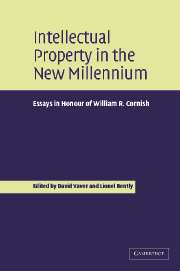Book contents
- Frontmatter
- Contents
- List of contributors
- Foreword
- Preface
- General intellectual property
- Patents and plant protection
- Trade marks and unfair competition
- 11 Dilution of a trade mark: European and United States law compared
- 12 Unfair competition: is it time for European harmonization?
- 13 Coexistence between the tort of passing off and freedom of slavish imitation in Polish unfair competition law
- 14 Confidentiality, patents and restraint of trade
- Copyright, moral and neighbouring rights
- William R. Cornish – curriculum vitae
- Index
11 - Dilution of a trade mark: European and United States law compared
Published online by Cambridge University Press: 25 May 2010
- Frontmatter
- Contents
- List of contributors
- Foreword
- Preface
- General intellectual property
- Patents and plant protection
- Trade marks and unfair competition
- 11 Dilution of a trade mark: European and United States law compared
- 12 Unfair competition: is it time for European harmonization?
- 13 Coexistence between the tort of passing off and freedom of slavish imitation in Polish unfair competition law
- 14 Confidentiality, patents and restraint of trade
- Copyright, moral and neighbouring rights
- William R. Cornish – curriculum vitae
- Index
Summary
Introduction
Professor Cornish has wisely warned us that: ‘What matters is that “dilution” … should be prevented only in cases where there really is sufficient cause for interfering with the freedom of all traders to promote their goods and services as best they can.’
No part of trade-mark law that I have encountered in my 40 years of teaching and practicing IP law has created so much doctrinal puzzlement and judicial incomprehension as the concept of ‘dilution’ as a form of intrusion on a trade mark. It is a daunting pedagogical challenge to explain even the basic theoretical concept of dilution to students, attorneys and judges. Few can successfully explain it without encountering stares of incomprehension or, worse, nods of understanding which mask and conceal bewilderment and misinterpretation.
With the advent of the 1988 EU Trade Mark Directive and a growing body of interpretive European Court of Justice (ECJ) case law, it is much easier than in the past to make a comparison of EU and US trade mark law, including anti-dilution law. While the anti-dilution provisions of Articles 4(4)(a) and 5(2) of the EU Directive are ‘optional,’ in fact, every EU nation has adopted them in its domestic law. In the US, since the enactment of the 1996 federal anti-dilution Act, in theory there is a uniform law consistent throughout the nation.
- Type
- Chapter
- Information
- Intellectual Property in the New MillenniumEssays in Honour of William R. Cornish, pp. 159 - 174Publisher: Cambridge University PressPrint publication year: 2004
- 1
- Cited by



